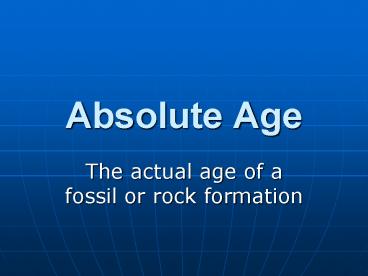Absolute Age - PowerPoint PPT Presentation
1 / 22
Title:
Absolute Age
Description:
Absolute Age The actual age of a fossil or rock formation What are atoms? What is a radioactive element? The atoms of many elements exist in different forms. – PowerPoint PPT presentation
Number of Views:146
Avg rating:3.0/5.0
Title: Absolute Age
1
Absolute Age
- The actual age of a fossil or rock formation
2
What are atoms?
The smallest unit of matter that makes up
everything on Earth.
What are elements?
Matter that is made up of the same atoms.
3
What is a radioactive element?
- The atoms of many elements exist in different
forms. - Most of these forms are stable and do not change.
- But some of these forms are said to be unstable
elements. - Its these unstable elements that are called
radioactive.
4
What are some examples of radioactive elements?
- Carbon -12 (stable) Carbon-14 (unstable)
- Potassium 39 (stable) Potassium-40 (unstable)
5
What is radioactive decay?
- Radioactive (unstable) elements want to be
stable. - The atoms of an unstable element (parent
material) break down to become atoms of another
element (daughter material). - This process of an unstable element breaking down
to become a stable element is called RADIOACTIVE
DECAY
6
(No Transcript)
7
(No Transcript)
8
What is radioactive dating?
- Radioactive dating is how scientists use
radioactive elements to determine the absolute
age of fossils rocks.
9
Why are radioactive elements used to determine
the absolute age of rocks fossils?
- The radioactive decay of unstable elements,
always happens at the same rate (speed). - If you know how fast it breaks down, then you can
figure out how much time has passed by.
10
What is a half-life?
- The time it takes for a radioactive element to
decay (become stable) is measured in half-lives. - A half Life is the amount of time it takes for
half of the radioactive atoms (unstable atoms) in
a sample to change into a stable element. - Different radioactive elements have different
half-lives.
11
(No Transcript)
12
What are some examples of radioactive elements
half-lives?
- Carbon-14 changes into Nitrogen-14
- half-life of 5,730 yrs
- Potassium-40 changes into Argon-40
- Half-life of 1.3 billion yrs
- Urianium-235 eventually changes into Lead-207
- Half-life of 704 million yrs
- Urianium-238 eventually changes into Lead-206
- Half-life of 4.5 billion yrs
13
(No Transcript)
14
Half-life Example
- The half-life of C-14 is about 5700 years.
- (Every 5700 years, HALF of the C-14 changes!)
- You have 60 grams of Carbon-14.
- After 5700 years pass, how much C-14 would you
have? N-14? - Now you have 30g of C-14 30g of N-14
- Another 5700 years go by.
- How much C-14 would you have? N-14?
- 15g of C-14 45g of N-14
- This would continue until all the unstable
element becomes stable.
15
How is absolute age found from radioactive dating?
- In radioactive dating, scientists first find out
how much radioactive element is in the sample. - Then, they compare the radioactive amount to the
stable amount. - The ratio between stable and unstable lets
scientists know how many half-lives the fossil or
rock has gone through, and therefore, how old
they are.
16
(No Transcript)
17
Radioactive dating can only be used on what?
- Absolute age can only be determined for igneous
rocks - Any fossils that have some organic parts
remaining - for example original remains, carbon film, bones
that are only partially petrified.
18
When does radioactive decay begin?
- In non-living things, radioactive decay starts as
soon as the magma or lava hardens. - OR
- In living things, every time an organism dies a
stopwatch starts ticking. - Death starts the stopwatch.
- Science can read it.
19
Why cant we find the absolute age of sedimentary
rocks or of fossils made from sediments?
- Sedimentary rocks and fossils made from sediments
are formed from millions of pieces of particles
that come from rocks of all different ages. - Radioactive dating would find the ages of the
particles not the age of the whole rock. - Wed never know how old the rock really is!
20
How do scientists date sedimentary rocks?
- To date sedimentary rocks, scientists find the
age of any intrusions or extrusions that are near
the sedimentary rock. - So, any layer of sedimentary rock above an
intrusion or extrusion, is YOUNGER! Any
sedimentary layer found below an extrusion is
older. - (RELATIVE AGE!!!)
21
How old is the Earth?
- The oldest rocks ever found on the Earth have
been dated at about 4.0 billion years old, but
scientists believe the Earth is really - 4.6 billion years old.
22
How do we know how old the Earth is?
- Scientist believe the Earth and the moon formed
at the same time. - Scientist have dated moon rock brought back to
Earth by astronauts. - Therefore the Earth is believed to be at least as
old as the moon rocks.































